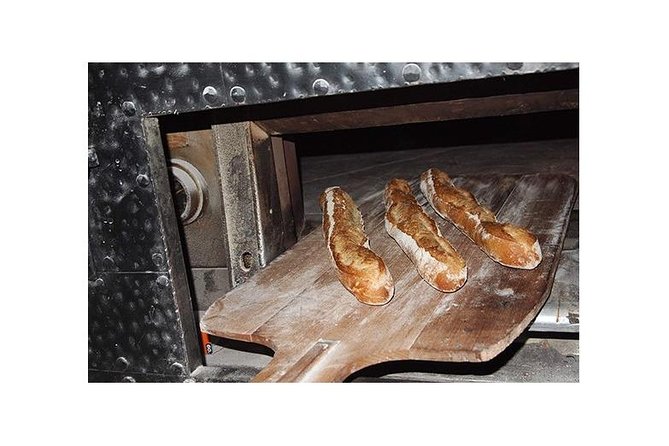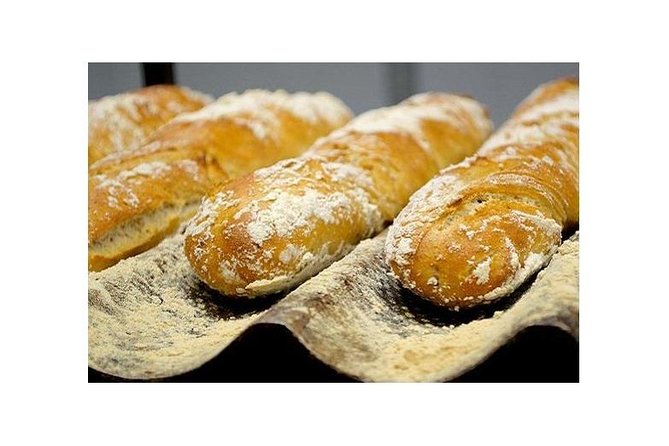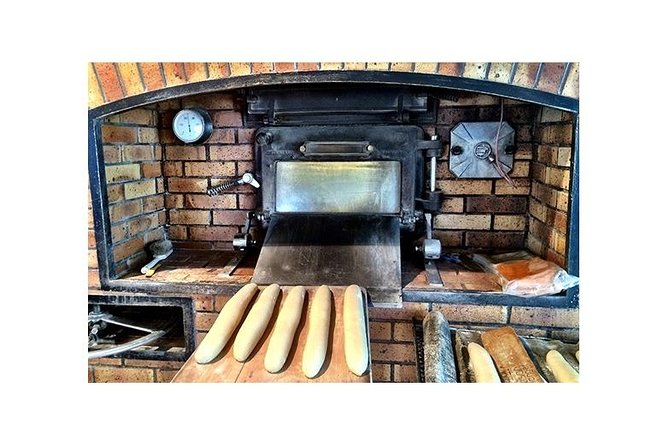Manufacturing of the Traditional French Baguette
In a world filled with complexities, the simplicity of a traditional French baguette’s manufacturing process stands as a beacon of consistency and heritage. Behind the scenes of a bustling bakery, a symphony of flour, water, yeast, and salt comes together in perfect harmony to create this beloved loaf.
But what truly sets apart a mediocre baguette from an exceptional one lies in the finesse of its production. Stay tuned to unravel the secrets behind the meticulous shaping techniques, precise baking methods, and the final touch that gives the French baguette its signature crunch.
Key Points

- The French Baguette symbolizes French culinary heritage and craftsmanship.
- Specific ingredients like flour, yeast, water, and salt are crucial for authentic flavor and texture.
- Traditional shaping techniques and baking methods are essential for the iconic form and taste.
- Skilled artisans use precise kneading, scoring, and baking techniques to achieve the perfect crust and crumb.
Here's some more nearby activities we've reviewed
History of the French Baguette

The history of the French baguette dates back to the early 19th century when it became an iconic symbol of French culinary tradition and culture. French bread has been a cornerstone of French cuisine for centuries, but the baguette, with its long, slender shape and crisp crust, holds a special place in the hearts of the French people.
Beyond its role as a staple food, the baguette carries cultural significance, representing the artistry and craftsmanship of French bakers. Its popularity spread rapidly throughout France, becoming synonymous with French dining and lifestyle. The baguette’s history is intertwined with the evolution of French society, making it not just a bread but a symbol of French identity and tradition.
Ingredients Required for Baguette

Dating back to the early 19th century as an iconic symbol of French culinary tradition, the baguette requires a simple yet precise selection of ingredients to achieve its characteristic taste and texture. When preparing a traditional French baguette, the following key ingredients are essential:
-
Flour types: The choice of flour used in baguette making is crucial. Typically, a combination of high-protein bread flour and all-purpose flour is preferred to achieve the perfect balance of chewiness and crustiness.
-
Yeast: Active dry yeast or fresh yeast is essential for the fermentation process, aiding in the rise and development of the baguette’s airy crumb structure.
-
Mixing, Kneading: Proper mixing and kneading techniques are vital to ensure the gluten in the dough is well-developed, resulting in the desired texture and structure of the baguette.
Traditional Baguette Making Process
Set out on an immersive journey into the artistry of crafting the iconic French baguette by delving into the step-by-step traditional baking process. The journey begins with the meticulous preparation of the dough, combining flour, water, yeast, and salt to create the perfect texture and flavor.
Once the dough is ready, skilled hands shape it into the distinctive long, slender form that characterizes the baguette.
Next comes the crucial step of baking in the oven, where artisan bakers utilize specific techniques to achieve crust perfection. The baguettes are baked at high temperatures to create a crispy, golden exterior while maintaining a soft, airy interior. These oven techniques are essential in capturing the authentic taste and texture of a traditional French baguette.
Importance of Proper Shaping Techniques
Proper shaping techniques in traditional French baguette making play a pivotal role in achieving the iconic slender form and desired texture of the final product.
- Shaping methods: Skilled artisans use specific techniques to roll and elongate the dough, giving it the characteristic shape and structure.
- Artisanal touch: The hands-on approach of shaping imparts a unique quality to each baguette, showcasing the expertise and individual style of the baker.
- Dough consistency: Ensuring the dough is properly shaped maintains the desired consistency throughout the baguette, leading to consistent baking results with a crispy crust and a soft, airy interior.
These elements combined contribute to the authentic taste and appearance of the traditional French baguette.
Baking and Finishing Touches
To achieve the perfect traditional French baguette, the baking process and finishing touches are crucial steps that enhance the flavor and texture of the iconic bread. Proper kneading ensures the dough’s gluten structure develops, creating the baguette’s characteristic chewy texture. Bread scoring before baking allows the dough to expand properly in the oven, resulting in the classic split down the middle and a crispy crust. Maintaining the ideal baking temperature is essential for achieving the baguette’s golden exterior. Proofing, the final rise before baking, impacts the baguette’s airy crumb structure. Here is a table summarizing key aspects of baking and finishing touches:
| Baking and Finishing Touches | Details |
|---|---|
| Bread Scoring | Allows dough expansion |
| Kneading | Develops gluten structure |
| Baking Temperature | Determines crust color |
| Proofing | Affects crumb structure |
Tips for Achieving the Perfect Crust
For achieving a perfect crust on your traditional French baguette, consider mastering the art of precise scoring techniques during the baking process.
-
Crust secrets: Utilize a sharp blade to score the dough just before baking. The depth and angle of the cuts affect the expansion of the dough during baking, resulting in a crispy crust.
-
Baking techniques: Ensure the oven is adequately preheated and use steam at the beginning of the baking process to create a moist environment, promoting crust development.
-
Texture tips, Flavor enhancements: Brushing the dough with water before scoring can help achieve a glossy finish, while adding seeds or a light dusting of flour before baking can enhance both texture and flavor.
Serving Suggestions and Pairings
To elevate the experience of enjoying a freshly baked traditional French baguette, consider the serving suggestions and ideal pairings that enhance the flavors and textures of this iconic bread. When serving a traditional French baguette, it pairs exceptionally well with a variety of wines and cheese platters. Here are some recommended pairings to enhance your baguette experience:
| Wine Pairings | Cheese Platters |
|---|---|
| – Chardonnay | – Brie |
| – Pinot Noir | – Camembert |
| – Sauvignon Blanc | – Gruyère |
| – Merlot | – Roquefort |
Pairing your baguette with these wines and cheeses will complement the crusty exterior and soft interior of the bread, creating a harmonious blend of flavors.
Baguette-Making Workshop Details
The Baguette-Making Workshop immerses participants in the traditional art of crafting and shaping the iconic French baguette under the guidance of a skilled artisan-baker.
- Participants learn about the intricate baguette scoring techniques used by artisan bakers, distinguishing them from the methods employed in industrial production.
- The workshop delves into the importance of baguette dough hydration levels, highlighting how varying levels impact the final texture of the bread.
- Hands-on experience in shaping the dough and understanding the critical stages of baguette-making provide a unique insight into the craftsmanship behind this beloved French staple.
This workshop offers a comprehensive and engaging experience for those looking to explore the nuances of traditional French bread-making.
Here's a few more nearby tours and experiences we have reviewed.
Common questions
Are There Any Health Benefits to Consuming Traditional French Baguettes?
Traditional French baguettes offer minimal health benefits due to their low nutritional value. While they are a delicious treat enjoyed by many, they are primarily made of refined flour, which lacks essential nutrients compared to whole-grain options.
How Can I Store Freshly Baked French Baguettes to Maintain Their Freshness?
When storing freshly baked French baguettes to maintain their freshness, it’s best to wrap them in a paper bag or towel to preserve their crustiness. Avoid refrigeration as it can make the bread go stale faster.
Are There Any Regional Variations or Specialties When It Comes to French Baguette Making?
Regional variations in French baguette making showcase diverse flavors and techniques across France. Special ingredients like different types of flour or unique additives contribute to these variations, offering a delightful exploration of traditional French baking.
Can Traditional French Baguettes Be Made Gluten-Free or With Alternative Flours?
Traditional French baguettes can be made gluten-free using alternative flours, catering to dietary needs while preserving the essence of this iconic bread. Experimenting with different flour blends can create unique textures and flavors.
Is There a Specific Etiquette or Cultural Significance Associated With the Consumption of French Baguettes in France?
French baguette consumption in France carries profound cultural traditions and etiquette. It symbolizes community, freshness, and daily rituals. Sharing a baguette at meals fosters connection and appreciation for artisanal baking, reflecting French culinary significance.
Here's more of our most recent tour reviews happening neaby
- Paris: Express Walk With a Local in 90 Minutes
- Lost Generations in Montparnasse: A Self-Guided Audio Tour
- An Exclusive Eiffel Tower Photography Adventure
- Paris: La Nouvelle Eve Cabaret Show With Champagne
- Paris : Jaat Museum Ticket
- Explore Europe With 10GB High-Speed Premium Esim Data Plan
- From Paris: Full-Day Guided Tour of Versailles
- Discovery of Cuban Rum and Cigars
- South Pigalle Paris: The Cool Apéro Food Tour
- Discovering Le Marais: Guided Walking Tour of Paris
- Paris: 2-Hour River Seine Lunch Cruise
Last Words
Set out on a journey through the rich history and artistry of traditional French baguette making.
From the selection of high-quality ingredients to the precise shaping techniques and baking process, this workshop offers a hands-on experience that will leave you with the skills to create the perfect crust and delicious bread at home.
Join us in Paris for a memorable and educational experience that will elevate your baking skills to new heights.